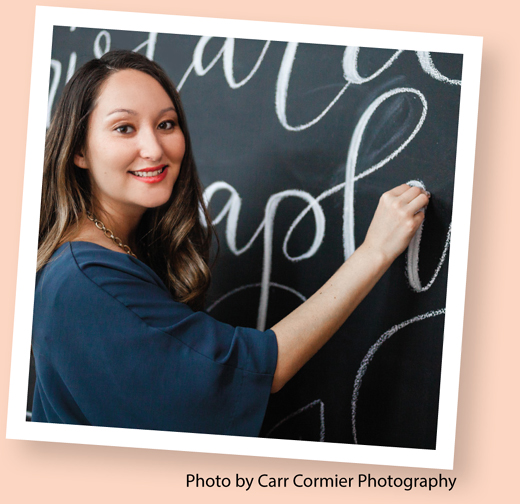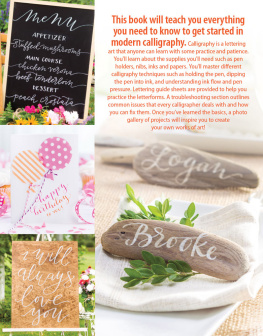If you are an Annies customer and have a question about the instructions on a pattern you have purchased, please visit:
AnniesCatalog.com/pages/customer_care/pattern_services.html
Templates
To download templates for easy printing, view the download instructions at the end of this book or click the Templates chapter in the Table of Contents.


For my parents,
who always told me to dream big.
Table of Contents
Contrary to popular belief, calligraphy and handwriting are two very different things (although learning calligraphy will help you improve your handwriting). What makes calligraphy unique is the variation of thick and thin linesthe contrast within the letterforms.
I believe that anyone at any age can learn how to write beautiful calligraphy. It just takes practice and patience. I first fell in love with calligraphy and began teaching myself when I was 12, after I found a book at my grandmas house. Maybe you want to learn how to address your own wedding invitations, or maybe you just want to take your snail mail to the next level. No matter what your reason is, its never too late or too early to learn.
Old-school calligraphy was all about perfection. What I love about modern calligraphy is that its all about personalization. There are so many different ways you can write the same letter. There are no more strict rules to follow. And flaws are OKtheyre even encouraged. Modern, creative calligraphy is all about creating letterforms that fit your own unique style and aesthetic.
This book will teach you everything you need to get started in modern calligraphy. It starts with the basics, because you cant break the rules until you know them. Youll learn all about typography terminology, the anatomy of a nib, how to assemble and prepare your pen, how to hold your pen, how to dip your pen, how to make a stroke, and finally, how to write letterforms and words.
Once you have that down, well dive into things like troubleshooting and fun stuff like writing on different mediums. Before you know it, youll be adding your own stunning touch to envelopes, place cards, stationery, chalkboards and everything in between.
Write on!
Kristara
Designer Bio


Kristara Schnippert has been a calligrapher for over 16 years, after teaching herself broad- and fine-tip calligraphy when she was just 12 years old. Known for her modern take on calligraphy, Kristara has worked with countless couples and corporate clients to incorporate hand lettering into their wedding stationery, event signage and brand identity. Her work has been featured in numerous print and online publications, including The Knot, Southern Bride, Style Me Pretty, 100 Layer Cake and Wedding Chicks. When shes not teaching workshops or making a huge mess in her studio, she enjoys biking around Houston with her husband, Dan, and their pup, Dallas.
Follow her on Instagram (@kristara) or visit www.kristara.co to see her latest work.
Beautiful calligraphy starts with the right supplies. Investing in quality supplies will save you a lot of time and frustration. Every nib, ink and paper has its own unique personality. An ink may write beautifully on one type of paper, but bleed on the next. Certain nibs work best on smooth paper, while others can handle a little more texture. Here are the supplies youll need to get started.
Nibs
There are two main types of nibs for dip pens. The broad-tip nibs have a chiselled tip, which calligraphers use to write more traditional calligraphy styles like Italic or Gothic. Then there are pointed nibs, which are used to write script styles like the modern calligraphy in this book.
Broad Nibs

To achieve the thick and thin lines in broad-tip calligraphy, you want to position the nib at about a 45-degree angle and not change the angle as you write. The angle can change depending on what particular alphabet youre writing. With broad-tip pens, you also have to pay attention to nib widths, which help you maintain the proportion of your letters. Calligraphy markers and fountain pens all have broad nibs.
Pointed Nibs

Calligraphers use pointed nibs for traditional copperplate and more modern styles of calligraphy. With pointed-pen calligraphy, you get the thick and thin lines by applying pressure to the pen. You also hold these types of pens differently than you do in broad-nib calligraphy. You want to hold the pen at about a 55-degree angle from the horizontal; imagine the point of the tip pointing toward the right corner of your paper. If youre right-handed, this is going to feel a little awkward at first, but I promise youll get used to it!
Getting to Know Your Pointed Nib
In order to use your nib correctly, its important to know how your nib works.

Point: The point is critical to getting crisp lettering. A nibs point is very fragile, so you dont ever want to handle your nib by the point. Also, you want to be extremely careful when youre cleaning your pen; if you damage the point, it wont write correctly anymore.
Tines: The tines create the thick and thin lines. When you apply pressure to the tines, they spread apart to give you nice, thick downstrokes. When you release the pressure and glide your pen across the paper, youll get thin, wispy hairlines. These pressure contrasts are what make pointed-pen calligraphy so beautiful and elegant.
Vent: The small hole in the center of your nib serves as the reservoir for your pen by holding the ink and helping it flow so youre not constantly redipping. The vent is important for you to remember because when you dip your pen into the ink, you want to make sure you dip it in just past the vent. In broad nibs, there is an external reservoir that you slide onto your nib to hold the ink.
Base: You always want to grip your nib by the base when youre handling it. Depending on your pen holder, the base may be a little tight or a little loose. I always keep a pair of needle-nose pliers handy to adjust it as needed. Simply squeeze the base a little bit at a time until the fit is right. When youre inserting your nib into the pen holder, you never want to force it in, but you dont want it to be too loose, either.
My Favorite Nibs
Its hard to say which nib is the best, because its so subjective, but here are the nibs I find myself reaching for the most:
Zebra G Nib
The Zebra G nib was originally used to draw manga art in Japan. Its a fairly stiff nib and great for beginners as you get used to applying pressure.














